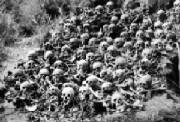|
From
a distant view, the scene unfolded as nothing more than an enormous mushroom cloud. Close up, only the eyes of those who survived
can describe exactly what happened.
People who still stood, not heavily injured, were quite distracted by the beaming light. So distracted, that the US
Air Force’s plane, the Enola Gay, after dropping the first atomic bomb, flew by unnoticed.
Hiroshi Sawachika, 28, was an army doctor stationed
at headquarters in Ujina, another city of Japan. When the bomb exploded, he was 4.1 km from the hypocenter, the eye
of the disaster. When he entered his office, the windows had already been shattered and the
frames were blown off. He realized nobody was standing, the doctors were spread out on one side of the floor. He recalled
that. “After a while, I realized that my white shirt was red all over. I thought it was funny because I
was not injured at all. I looked around and then realized that the girl lying nearby was heavily injured, with lots of broken
glass stuck all over her body.”
Sawachika treated thousands of patients that night, but felt miserable for one in particular. A pregnant woman looked at
him with pleading eyes, telling the doctor she was going to die, but needed one last favour. “I don't mind if I die.
But if the baby is delivered now, it does not have to die with me. Please help my baby live,” she pleaded. There was
no delivery room; everything had been swept away like dust. All he could say was that he’d come back later, after treating
patients in more immediate need..
Sawachika came
back later to check up on the lady. She looked life-less, a view that had come very familiar in the last few hours. The person
lying next to her mentioned that she had become silent a while ago. “I still recalled this incident partly because I
was not able to fulfill the last wish of this dying young woman.”
The rain had fallen
in contact with the mushroom cloud, causing remnants of both, the bomb and radiation to fall all over the land. “When
it fell on trees and leaves, it stayed and turned everything black,” described Isao Kita, 33, working for Hiroshima
District Weather Bureau, was 3.7 km away from the scene, and he witnessed the repulsive: “The smoke was so thick that
it covered the entire town. And it’s not an easy death, it’s a very cruel and very painful way to die,”
by radiation, heat and poisoning.
Meanwhile, the spark of the flashing light remained in the eyes and mind of every witness, some even lost
their sight as they looked upon it.
“It was
so bright, a ten or hundred or thousand times brighter than a camera flash bulb. The flash was piercing my eyes and my mind
went blank,” sobbed Ms. Kinue Tomoyasu, 44. She was at home, 5 kilometers from the bombing.
She then entered Hiroshima City to
search for her daughter, but the little girl was dead.
“It was like a white magnesium flash,” said Ms. Akiko Takakura, 20, who was 300 meters away from the incident.
“The whirlpool of fire that was covering the entire street approached us…the rain drops were so big that we even
felt the pain when they dropped onto us.”
A catastrophe as inexpressible as this caused many citizens to lose their minds.
Ms. Toshiko Saeki, lost thirteen members of her family in the A-bomb
attack. A man who had nothing covering his body passed by her, and not knowing why, she ran back to him asking, “Which
part of Hiroshima was attacked?”
He replied, “You’re Toshiko aren’t you? Toshiko! Toshiko!” She couldn’t recognize him
at first. “Toshiko! It’s me! You can’t tell?” Then she realized who it was; it was her second eldest
brother, and he barely recognizable.
In those mere seconds, approximately
80 000 people, struck by a wave of intense heat, died like flies. Others lay writhing like worms, atrociously burned. Many
pulled burning clothes from their flesh as they ran screaming and naked down the streets. Every house close to the heart of
the blast disappeared as if swept away by a supernatural power. Streetcars were picked up and hurled yards away, and trains
were flung off the rails, like everything was weightless.
No single individual
could really claim to be "the inventor" of the bomb, since the possibility sprang naturally from a physical process, and required
the efforts of many thousands to create the a-bomb, named Little Boy. Overall,
it was a simple mistake. The team of inventors wanted to use it as a clean power source, but the government used it to kill
80% of Hiroshima’s population in less than 3 minutes, to stop the Second
World War. It was originally generated to attack Germany,
but no matter where it was essentially supposed to be dropped, it caused a lot more damage than what we thought it was capable
of.
While human beings master new possibilities in scientific development, moral standards must
be carefully recognized to protect the innocent children and families.
A bomb now exits that could potentially end the world,
and humanity. Will humans eventually cause their own demise? In the name of what “power”? Is this not an extreme
way of ending a war, not to mention that it punishes the innocent – those not involved?
Go Back Up
|
 |
|

Remaining skulls of those who passed.
|
 |
|
|
 |
|
|
|

